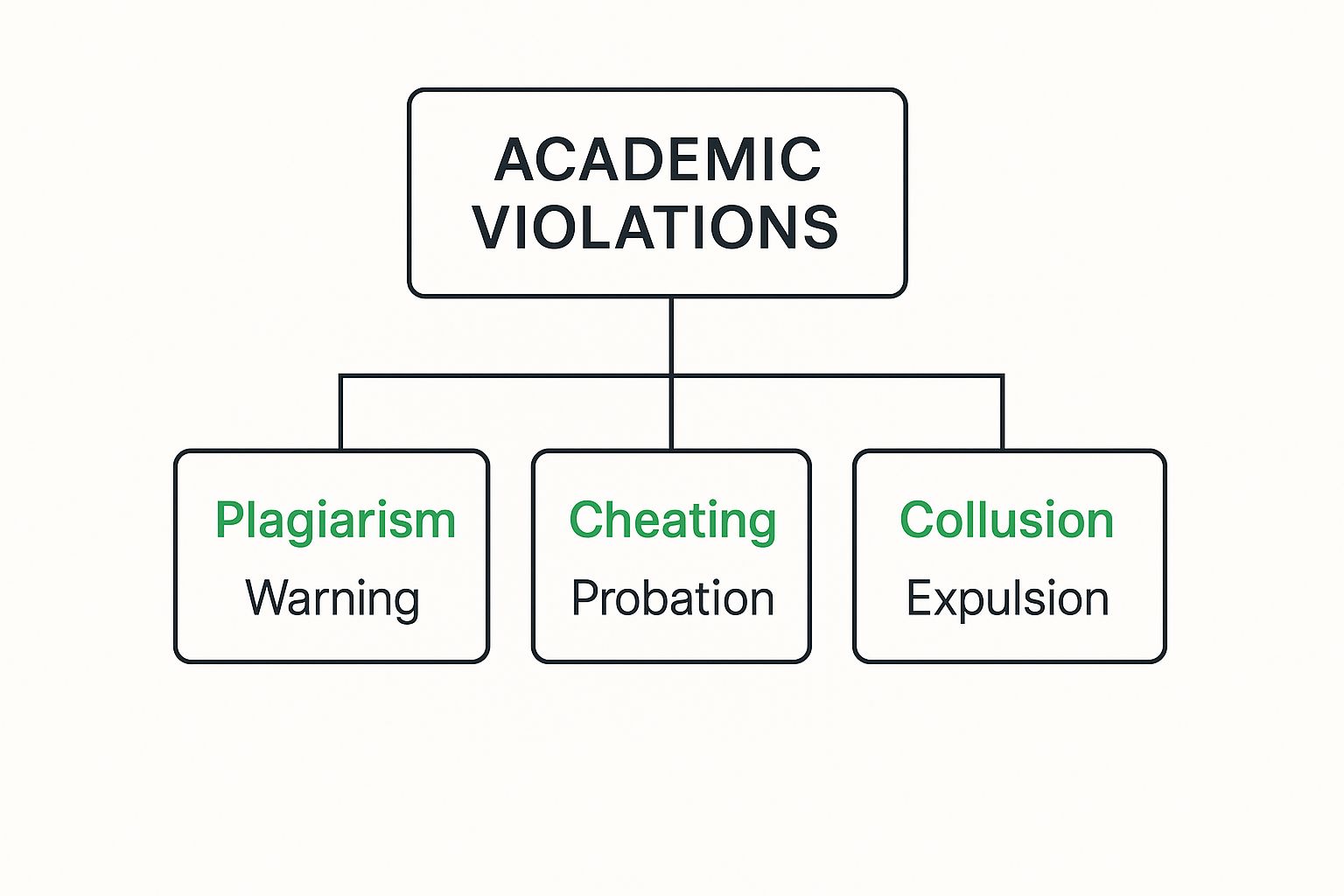
Academic Integrity Guidelines That Build Trust & Success
June 15, 2025
Understanding Academic Integrity Beyond The Rulebook
Think of academic integrity as the bedrock of education. It's like the foundation of a house – essential, even though you don't see it every day. Without it, the whole structure is unstable. This means we need to go deeper than just telling students "don't cheat." We need to explore what academic integrity truly means in today's world.
In our hyper-connected world, information is readily available. Answers are just a click away. But real learning isn't about simply finding the answers. It's about developing the skills to search, understand, and apply knowledge. Academic integrity guides students toward this deeper understanding. It emphasizes the process of learning, not just the final grade.
Furthermore, academic integrity isn't just about good grades. It's about developing core values like honesty and responsibility. These values are important not just in school, but also in professional life. Employers look for people who can think critically, solve problems independently, and maintain high ethical standards. These traits, cultivated through a commitment to academic integrity, are invaluable in any career.
A Shift in Focus: From Rules to Values
Academic integrity frameworks are changing. They are moving beyond strict rules and punishments. Across major higher education markets, like the European Union and North America, there's a growing emphasis on foundational values.
A 2025 guide from the FAITH Project, supported by the Erasmus+ Programme, highlights key values:
- Honesty
- Trust
- Fairness
- Respect
- Responsibility
- Courage
These values form the core of effective institutional policies. Leading institutions are building relationships and fostering a culture of integrity. Instead of a “catch and punish” system, they're focusing on education and support. This approach recognizes that true academic integrity comes from understanding why it matters.
This shift to values helps students learn from mistakes and develop a strong ethical compass. Ultimately, academic integrity is about a lifelong commitment to honesty, fairness, and responsibility – in learning, work, and life.
The Six Pillars That Transform Educational Culture
Imagine building a house. You wouldn't start with the roof, would you? You'd lay a strong foundation and erect sturdy pillars to support everything above. Academic integrity works the same way. It's built upon six fundamental values: honesty, trust, fairness, respect, responsibility, and courage. These values aren't just abstract ideals; they're the bedrock of a meaningful and lasting educational experience.
Honesty is the cornerstone, the foundation upon which everything else rests. It's about presenting your own work authentically, acknowledging your sources, and being upfront about your limitations. Think of it like this: if you try to build a house on a shaky foundation, the whole structure is compromised. Similarly, dishonesty undermines the integrity of the entire learning process.
Honesty naturally fosters trust, creating an environment where open communication and collaboration can thrive. Picture a classroom where students feel comfortable admitting they don't grasp a concept. This vulnerability, born from trust, allows for deeper learning and stronger relationships between students and instructors.
Fairness is another essential pillar. Academic integrity guidelines should apply universally, creating a level playing field for everyone, regardless of background. This means that assessments should be equitable, grading criteria transparent, and opportunities for success accessible to all. Just as a house needs evenly distributed support, a fair academic environment ensures that all students have the chance to excel.
But academic integrity isn't just about rules and regulations; it's about respect. Respect for yourself, your peers, your instructors, and the learning process itself. This includes valuing diverse perspectives, engaging in thoughtful discussions, and acknowledging the intellectual property of others. Think of it as respecting the blueprints of the house – the foundational knowledge and contributions of those who came before you.
Responsibility also plays a key role. Students are responsible for their own learning journey and must actively choose to uphold academic integrity. They are the builders of their own educational "houses," and the quality of the finished product depends on the integrity of the materials and methods they use.
Finally, we come to courage. Sometimes, upholding academic integrity requires standing up for what's right, even when it's difficult. This might mean challenging questionable practices, reporting dishonest behavior, or admitting your own mistakes. It takes courage to point out a structural flaw in the "house," even if it means delaying the project.
These six pillars are interconnected and interdependent. Weakening one compromises the entire structure. Forward-thinking institutions understand this and are actively weaving these principles into the fabric of their educational culture.
To illustrate the practical implications of these values, let's take a look at the following table:
Core Academic Integrity Values and Their Practical Applications
A comprehensive breakdown of the six fundamental values with real-world examples of how they manifest in educational settings. This table helps to clarify how these abstract values translate into concrete actions and impact the overall academic environment.
| Core Value | Definition | Student Application | Faculty Application | Institutional Impact |
|---|---|---|---|---|
| Honesty | Truthfulness and authenticity in all academic work | Submitting original assignments; properly citing sources | Presenting research findings accurately; designing fair assessments | Builds trust and credibility within the academic community |
| Trust | Reliance on the integrity of others | Believing classmates will uphold academic standards; confiding in instructors | Trusting students to complete work honestly; maintaining confidentiality | Fosters open communication and collaboration |
| Fairness | Impartiality and equal opportunity | Expecting equitable grading practices; accessing support resources | Applying grading criteria consistently; providing accommodations as needed | Creates a level playing field for all students |
| Respect | Valuing others and their contributions | Engaging in respectful classroom discussions; acknowledging intellectual property | Treating students with respect; valuing diverse perspectives | Promotes a positive learning environment |
| Responsibility | Accountability for one's actions and learning | Completing assignments on time; upholding academic standards | Providing clear expectations and feedback; being accessible to students | Empowers students to take ownership of their education |
| Courage | Standing up for what's right, even when it's difficult | Reporting academic dishonesty; challenging unfair practices | Addressing academic misconduct fairly; advocating for ethical research | Creates a culture of integrity and accountability |
This table demonstrates how each value plays a distinct yet interconnected role in shaping the academic experience. By fostering these values, institutions create an environment where integrity is not just a rule, but a way of life.

The infographic above visualizes the potential consequences of various academic violations, from plagiarism to cheating and collusion. It clearly shows how the severity of the consequence corresponds to the severity of the infraction. While a first instance of plagiarism might result in a warning, cheating on an exam could lead to probation, and collusion on a major project might result in expulsion. These defined consequences act as a deterrent and underscore the importance of adhering to academic integrity guidelines. Ultimately, these guidelines create environments where integrity is not just enforced but becomes an integral part of the learning process itself.
Navigating The AI Revolution In Academic Honesty

The rise of artificial intelligence (AI) tools like ChatGPT is shaking up the world of academic integrity. These tools can write essays, answer questions, and even generate creative content that's remarkably human-like. This makes it tough to tell the difference between a student's original work and something created by AI, blurring the lines of plagiarism and academic honesty.
Imagine a student using AI to create an essay outline. Is that crossing the line? What if they use AI to polish their sentences while keeping their own ideas intact? These are the real questions educators are wrestling with as AI becomes a common tool in the classroom.
The integration of AI in education isn't some distant future; it's happening right now. The influence of AI on academic honesty has reached a critical point, changing how students learn and how institutions respond. A May 2025 report found that a staggering 89% of students globally are using AI tools like ChatGPT for their academic work. This highlights the limitations of traditional plagiarism checkers. For a deeper dive into this changing landscape, check out this insightful resource: Moving Beyond Plagiarism and AI Detection: Academic Integrity in 2025.
Rethinking Academic Integrity in the AI Era
It's clear that old definitions of plagiarism and cheating are no longer enough. Academic integrity guidelines need an update to deal with this new reality. This means moving beyond simply catching AI-generated text and understanding how students are using these tools.
Instead of focusing on penalties, institutions should prioritize education and support. Students need guidance on how to use AI responsibly and ethically.
This requires a shift in perspective. Using AI for brainstorming or checking grammar might be perfectly acceptable, while submitting AI-generated text as original work is clearly dishonest. This difference needs to be communicated clearly through updated guidelines. Students must understand the ethical implications of using AI in their studies.
For those curious about the technical side, this article offers some perspectives: How to Make AI Writing Undetectable. Ultimately, fostering academic integrity in the age of AI requires open conversation, adaptable guidelines, and a focus on ethical AI use. This collaborative approach will help both educators and students navigate this new educational frontier.
From Detection To Prevention: Modern Implementation Strategies

Think of traditional academic integrity practices like patching a leaky roof after the downpour – a reactive scramble to fix the damage. Instead, imagine reinforcing that roof before the storm. That's the shift happening now: a move towards prevention. Leading institutions are ditching the reactive "catch and punish" approach for a proactive system that builds integrity from the ground up.
This means moving beyond simply spotting academic dishonesty. It’s about cultivating a culture where integrity is the norm. Instead of solely relying on plagiarism checkers like Turnitin, universities are investing in programs that teach students the essentials: proper citation, solid research methods, and the value of original thinking. This empowers students to make ethical choices upfront, not just react to the threat of penalties.
Many institutions are also incorporating honor codes and peer-to-peer feedback. This fosters a sense of shared responsibility – integrity becomes a communal value, not just a box to check.
Balancing Technology With Human Judgment
Technology is a game-changer in upholding academic integrity, but human judgment is still key. AI-powered tools can flag potential plagiarism or cheating, but they're not perfect. Context matters. A flagged passage might be unintentional plagiarism due to a citation error, not deliberate dishonesty. That's where educators’ expertise comes in. Their understanding of student learning, coupled with a careful review, ensures fair assessment.
The adoption of AI-based academic integrity tools by teachers has skyrocketed. A whopping 68% of educators now use AI-driven systems to detect academic dishonesty, a significant jump from previous years. You can dive deeper into these trends with this overview of AI plagiarism statistics. But this increasing reliance on technology needs a crucial counterbalance: thoughtful human oversight.
This balanced approach ensures technology supports educators, not replaces them. It also allows for tailored responses to individual student needs. A student struggling with citations might need extra guidance, while a student deliberately plagiarizing requires a different approach. This flexibility and personalization are core to modern strategies.
To illustrate the differences between reactive detection and proactive prevention, let's look at the following table:
Table: Detection vs. Prevention Strategies Comparison Description: Analysis of reactive detection methods versus proactive prevention approaches, showing effectiveness rates and implementation considerations.
| Approach Type | Methods Used | Effectiveness Rate | Student Response | Resource Requirements | Long-term Impact |
|---|---|---|---|---|---|
| Detection (Reactive) | Plagiarism software, proctored exams, investigative committees | Moderate (Catches some instances, but often after the fact) | Primarily fear-based; can lead to defensiveness and lack of trust | Moderate to high (Software costs, staff time for investigations) | Limited impact on long-term ethical development |
| Prevention (Proactive) | Educational workshops, clear guidelines and examples, honor codes, peer feedback | High (Reduces instances by fostering a culture of integrity) | Encourages understanding and responsibility; builds trust | Moderate (Curriculum development, training for faculty and students) | Fosters ethical decision-making and long-term academic integrity |
The table highlights a key difference: detection focuses on catching wrongdoing, while prevention aims to build a culture of integrity. Prevention, though requiring upfront investment in education and training, offers greater long-term benefits in fostering ethical academic practices.
The Power Of Education Over Enforcement
Education-centered programs, not just enforcement, yield far better long-term results. When students grasp why academic integrity matters, they internalize and practice it. This means going beyond simply listing the rules. Workshops, seminars, and interactive online modules help students understand integrity principles and how they apply to their own work. This fosters ownership and responsibility, leading to more authentic learning.
Educational programs can also address the root causes of academic dishonesty: the pressure for good grades, fear of failure, or simply not understanding proper research. By tackling these underlying issues, institutions create a more supportive, less stressful environment. This naturally discourages dishonesty and encourages intellectual growth. This proactive, education-focused approach builds a much stronger foundation for academic integrity than a purely reactive, enforcement-based model.
Real-World Application: Guidelines That Actually Work
So, we've talked theory. Now, let's get practical. How do academic integrity guidelines actually play out in the real world? How do schools transform these guidelines from dusty rulebooks into living, breathing parts of their culture? We'll look at some inspiring success stories, and also where some well-meaning efforts missed the mark.
Virginia Tech's Honor System: A Case Study
Virginia Tech's Honor System offers a fascinating example. It's a long-standing system, driven by students themselves, which speaks volumes. Take a look at this snapshot from their website:
Notice how they emphasize personal responsibility and community involvement. It's not just about following rules; it's about students taking ownership of academic honesty within their community. This peer-to-peer approach fosters trust and a sense of shared responsibility, a stark contrast to a top-down, "catch you if you can" approach. Student participation clearly plays a vital role in making it work.
Diverse Institutional Approaches
Different institutions are trying different things, and that makes sense. A community college, for instance, often has a very diverse student body, including people coming back to school after years in the workforce. For these students, clarity and support are key. Some community colleges have found success with mandatory academic integrity workshops during orientation. It's like setting the ground rules right from the start, ensuring everyone's on the same page.
Research universities face a different set of challenges. Think collaborative projects, grant proposals, and publications—all with their own intricacies. These universities are developing very specific guidelines for things like authorship, data management, and intellectual property. They offer tailored advice for different research fields, recognizing a one-size-fits-all approach won't cut it.
Learning From Successes and Failures
It's not always smooth sailing, even with the best intentions. Some universities learned the hard way that relying solely on automated plagiarism software can backfire. It created a climate of suspicion without actually decreasing plagiarism. Students felt unfairly targeted, and the focus shifted from learning to simply avoiding detection. For some helpful writing tips, check out this resource: How to Write Better Essays. These experiences show the importance of human judgment and the need to pair technology with educational support.
At the end of the day, success depends on building a culture where academic integrity isn't just a rulebook, but a value woven into the fabric of education. This requires ongoing conversations, transparent policies, and a shared commitment to a learning environment built on trust and respect. It's a continuous process of evaluating and refining, learning from both the victories and the setbacks.
Building Trust In An Age Of Constant Suspicion

The rise of detection tools has created a climate of suspicion in many schools. Students feel like they're always being watched. Even legitimate work can trip these automated alarms. This breakdown of trust makes real learning hard. Imagine learning to ride a bike while constantly looking over your shoulder, worried about being called out for doing something wrong. It stifles the joy and exploration that fuels true learning.
So, how do we keep things fair while also fostering a sense of trust? That's the big question educators are grappling with right now. It's a tricky balancing act between accountability and connection. We can't just ignore academic honesty, but we also can't let suspicion suffocate the learning process.
Open Communication: The Bridge to Trust
One of the best ways to build trust is simple: talk to students. Have honest conversations about academic integrity. Explain the why behind the rules—what's the real purpose of citing sources and doing original work? When students understand the value, they're more likely to embrace it. This transparency builds confidence and shared responsibility.
Also, give students a chance to voice their concerns. This could be through student forums, surveys, or just open office hours where they feel safe asking questions. This two-way dialogue creates a partnership, where students and educators work together to maintain academic integrity. For some further reading on clear communication, check out this guide on brand voice guidelines.
Shifting From Surveillance To Support
Many institutions are recognizing that constant monitoring can backfire. Instead of watching students like hawks, they're providing more support and resources. This might include workshops on citing sources, effective research strategies, or even time management. By equipping students with the skills they need to succeed, they’re empowered to make honest choices.
This shift also requires a change in perspective. Instead of seeing students as potential cheaters, educators need to view them as learners seeking guidance. This creates a more positive environment where students feel comfortable asking for help.
Addressing The Root Causes of Dishonesty
Sometimes, academic dishonesty happens because of underlying pressures. The pressure to get top grades, fear of failing, or just not understanding the expectations can lead students down the wrong path. Addressing these root issues is critical.
Think about offering stress management resources, exploring more flexible assessment methods, or simply having frank discussions about the challenges students face. Creating a supportive environment can help students overcome these obstacles and do the right thing.
Fostering a Culture of Integrity
Building trust comes down to creating a culture of integrity. This means weaving academic honesty into everything – classes, assignments, even social interactions. It’s not just about rules; it’s about building a community that values honesty, respect, and responsibility.
This takes a village. Students, faculty, and administrators all need to be on board. By working together, we can create places where trust isn’t just a word, but a daily reality, allowing authentic learning to thrive.
Your Roadmap To Implementing Effective Academic Integrity
Ready to turn good intentions into real change? This roadmap offers practical advice for implementing or improving academic integrity guidelines in any educational setting. We'll break the process down into manageable steps, from initial assessment to putting your plan into action, including realistic timelines and what resources you'll need. We'll also cover helpful checklists, common mistakes to avoid, and ways to measure your actual progress, not just surface-level compliance. Whether you're starting from scratch or refining existing policies, this section will give you the practical guidance you need for long-term success.
Phase 1: Assess Your Current Landscape (1-2 Months)
First, take an honest look at where you stand. What academic integrity guidelines are already in place? Are they well-understood and followed? Do they address current challenges, such as the use of AI? This initial assessment is the foundation for effective change.
Gather Data: Use surveys and focus groups with students and faculty to understand their perspectives and experiences.
Analyze Existing Policies: Figure out the strengths and weaknesses of your current academic integrity system.
Benchmark: Look at best practices at other institutions to get ideas and direction.
This phase helps you pinpoint gaps and focus on areas that need the most attention. It sets the stage for targeted, impactful change.
Phase 2: Develop & Refine Guidelines (2-3 Months)
This phase is about creating or updating your academic integrity guidelines. Working together is essential. Get students, faculty, and administrators involved to ensure everyone agrees and creates guidelines that work for the whole community.
Draft Clear Policies: Use plain language, skip the jargon, and give concrete examples.
Address AI: Include specific guidance on the responsible use of AI in academic work.
Establish Procedures: Outline clear processes for reporting and addressing academic misconduct.
Building consensus in this phase ensures that everyone feels heard and is invested in the success of the new guidelines.
Phase 3: Implementation & Training (3-4 Months)
Once your guidelines are finalized, it's time to roll them out. This involves training and communication to ensure everyone understands and adopts the new system.
Provide Training: Run workshops and online modules for students and faculty on the new guidelines.
Communicate Regularly: Use different channels (email, website, social media) to reinforce key messages.
Create Resources: Develop quick reference guides, FAQs, and online resources so everyone can easily find information.
Effective implementation depends on education and accessibility. Make it easy for everyone to understand and follow the new standards.
Phase 4: Ongoing Evaluation & Improvement (Ongoing)
Implementing guidelines isn't a one-time task; it's an ongoing process. Regular evaluation and improvement are crucial for long-term success.
Gather Feedback: Ask students and faculty for their thoughts on how well the guidelines are working.
Track Metrics: Monitor key indicators, such as reported incidents of academic misconduct, to gauge progress.
Adapt & Refine: Be ready to update your guidelines based on feedback and evolving situations.
Ongoing evaluation ensures your academic integrity guidelines stay relevant and effective, fostering a culture of integrity and trust within your educational community. Ready to write with more clarity and impact? Check out Natural Write, a free tool designed to help you refine your writing and ensure it’s original.


